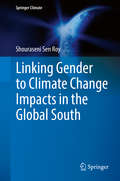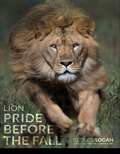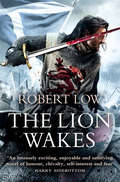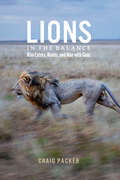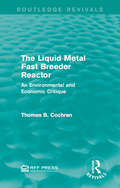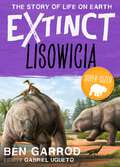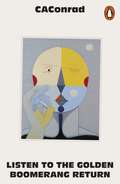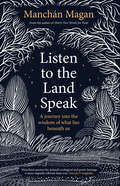- Table View
- List View
Linking Emissions Trading Schemes
by Andreas TuerkA growing number of GHG emissions trading schemes are being implemented at regional or national levels. However, even as the number of different schemes grows, few linkages exist between them. Major cap-and-trade proposals are currently at important stages in their development, especially in the United States, Japan and Australia, some of which explicitly emphasize the aim of linking with other schemes. One of the strategic goals of European climate policy is linking the EU ETS with other comparable schemes. The research presented in this volume is on actual economic, political and institutional constraints and implications. It examines the role of linking trading schemes for the development of the post-Kyoto climate architecture and for increasing linkage between schemes. This essential research will be relevant to both the scientific community and for policymakers who are involved in the design of emerging trading schemes and offset mechanisms, as well as in designing the post Kyoto climate regime. This volume focuses specifically on: o Economic, institutional/regulatory and legal dimensions of linking o Implications of linking on the design of emerging trading schemes o The role of linking trading schemes for the development of the post-Kyoto climate regime
Linking Gender to Climate Change Impacts in the Global South (Springer Climate)
by Shouraseni Sen RoyThis authored book assesses the spatial patterns of climate change and gender inequalities across the Global South, and analyzes the disproportionate impacts that climate change processes have on women in these regions. Though many books attempt to incorporate gender issues into climate change, this book examines the issue as a whole by addressing the relationship between climate change and gender from a number of perspectives. The book incorporates case studies from various regions of the Global South, a designation broadly defined as the countries of Africa, Middle and South America, and most of Asia including the Middle East. In the book's two main sections, readers will learn about how climate change affects access to regional opportunities and resources, the obstacles created by climate change that affect women more strongly than men, and how affected female populations adapt to changing conditions and protect their local livelihoods. Section one, covering chapters 1 and 2, addresses the spatial patterns of climate change and gender inequalities/inequities across the Global South by analyzing long-term trends from the latest reports of the Intergovernmental Panel on Climate Change (IPCC) and the World Economic forum. Section two, covering chapters 3 through 7, discusses the critical issues related to climate change and gender inequality, and presents literature reviews and case studies in the Global South. The different issues and perspectives discussed include health, water and food security, education, conflicts, migration, participation in decision-making processes, and changing urban social landscapes. The concluding chapter discusses policy initiatives and makes recommendations to some of the gender mainstreaming through empowerment and participation. This interdisciplinary book will appeal to academics and policy-makers beyond just the fields of environmental sciences and gender studies, and may be adopted as a resource for graduate students and researchers.
Linking Restoration and Ecological Succession (Springer Series on Environmental Management)
by Lawrence R. Walker Joe Walker Richard J. HobbsThis innovative book integrates practical information from restoration projects around the world with the latest developments in successional theory. It recognizes the critical roles of disturbance ecology, landscape ecology, ecological assembly, invasion biology, ecosystem health, and historical ecology in habitat restoration. It argues that restoration within a successional context will best utilize the lessons from each of these disciplines.
Linking the European Union Emissions Trading System: Political Drivers and Barriers (Routledge Focus on Environment and Sustainability)
by Charlotte UngerThis book focuses on the linking of the European Union Emissions Trading System (EU ETS) with other independent regional ETS. While rich practical and academic research has evolved on the economic and technical side of ETS linking, political drivers and barriers have so far been underrepresented in this debate. Filling this lacuna and based on international relations theory, existing research and qualitative fieldwork, this book introduces the range of political conditions that influence linking, such as political leadership and stakeholder activity. Specifically, it analyzes which of these aspects have played a role in three different linking activities of the EU: (1) a failed linking attempt: EU ETS–California Cap-and-Trade Program; (2) a successful linking treaty: EU ETS–Switzerland Emissions Trading System; and (3) an agreed-upon but not realized link: EU ETS–Australia Carbon Pricing Mechanism. Through an interrogation of these examples, Dr. Unger concludes that it is not only the technical challenges or the overall economic benefit but rather domestic interests, structural aspects, and external international political developments that have jointly dominated linking activities, especially those in which the EU takes part. This book will be of great interest to scholars and policy-makers working in climate policy and EU environmental politics.
Linking the European Union Emissions Trading System: Political Drivers and Barriers (Routledge Focus on Environment and Sustainability)
by Charlotte UngerThis book focuses on the linking of the European Union Emissions Trading System (EU ETS) with other independent regional ETS. While rich practical and academic research has evolved on the economic and technical side of ETS linking, political drivers and barriers have so far been underrepresented in this debate. Filling this lacuna and based on international relations theory, existing research and qualitative fieldwork, this book introduces the range of political conditions that influence linking, such as political leadership and stakeholder activity. Specifically, it analyzes which of these aspects have played a role in three different linking activities of the EU: (1) a failed linking attempt: EU ETS–California Cap-and-Trade Program; (2) a successful linking treaty: EU ETS–Switzerland Emissions Trading System; and (3) an agreed-upon but not realized link: EU ETS–Australia Carbon Pricing Mechanism. Through an interrogation of these examples, Dr. Unger concludes that it is not only the technical challenges or the overall economic benefit but rather domestic interests, structural aspects, and external international political developments that have jointly dominated linking activities, especially those in which the EU takes part. This book will be of great interest to scholars and policy-makers working in climate policy and EU environmental politics.
The Lion: Behavior, Ecology, and Conservation of an Iconic Species
by Craig PackerAn authoritative, accessible, and gorgeously illustrated exploration into the lives of these remarkable animalsLions are the only social cat. They hunt together, raise cubs together, and defend territories together against neighbors and strangers. Lions also rest atop their ecological pyramid, with profound impacts on competitors and prey alike, but their future is far from assured. Craig Packer interweaves his discoveries from more than forty years of research—including a substantial body of new findings—to provide an unforgettable portrait of the African lion. He shares insights into the intricacies of lion life from birth until death and describes efforts to conserve lions in an increasingly crowded continent. With a wealth of breathtaking photographs by Daniel Rosengren, The Lion sheds light on a host of intriguing scientific questions, such as why males have manes, why lions are social, how sociality limits and stabilizes lion populations, how close inbreeding affects lion health, why lions become man-eaters, how lions and people can best be protected from each other, and how to ensure the lion’s survival into the next century.Engagingly written by the world’s foremost expert on African lionsIntegrates a wealth of findings from two of the most comprehensive field studies on any animalFeatures hundreds of stunning photographs that capture a broad range of lion behaviors, ecological interactions, and conservation challengesBlends vivid field anecdotes and graphics to give the reader a sense of adventuring into the lion’s world
Lion: Pride Before The Fall
by George LoganAcclaimed wildlife photographer George Logan’s book of stunning wildlife photography produced to support and raise awareness of Africa’s dwindling’s lion population is now available as an eBook.The book, Lion: Pride Before The Fall, contains a collection of the London-based photographer’s beautiful and thought-provoking images of lions in the wild in Africa.The photographs, which celebrate the lifecycle of the lion in all of its raw beauty, serve as a stark reminder of what we stand to lose – and with fewer than 20,000 African lions left, time is running out to safeguard their future.The foreword to the book was written by Born Free founder and actress, Virginia McKenna OBE. She says: “No one, in my view, more strikingly has caught the multiple dimensions of lions’ behaviour and depth of character than George Logan. He has an unfailing sensitivity and admiration for the individual animal. This, for me, shines through each page of the book and is deeply moving in so many ways.”George Logan says: "This work, the culmination of over 10 years following and photographing Africa’s lion prides, brings their dramatic narrative to life. It’s difficult to articulate the depths of what we stand to lose, but I hope that through this book, the lions will help tell that story. All profits from this book will raise vital funds to support, protect and help re-establish the Last Lions of Meru, a major conservation initiative in Kenya, which works to protect and increase the lion population there, which currently stands at just 60-80 lions.”“Uniquely for a wildlife book, we’ve collaborated with some of the best creative minds at London's top agencies to produce powerful imagery which confronts and highlights the dangers that the last remaining lions still face, such as habitat-loss, canned hunting, trophy hunting, human-wildlife conflict and the real possibility of extinction.
The Lion Wakes: The Lion Wakes, The Lion At Bay, The Lion Rampant (The Kingdom Series)
by Robert LowThe first novel in The Kingdom Series as Robert Low moves from the Vikings to the making of Scotland.
Lions in the Balance: Man-Eaters, Manes, and Men with Guns
by Craig PackerIf you are a morani (warrior), you have your spear at the ready—you could be the hero, but you will have to wait until the morning light before you can go out and prove yourself. If it is a lion, you want to be the first to spear it—and if the lion turns on you, make sure it mauls you on your chest or stomach, on your face, shins, or throat. Any place where you can show your scars with pride, show the incontrovertible evidence of courage. A scar on your back would be a permanent reminder of cowardice, an ineradicable trace of shame. Monsters take many forms: from man-eating lions to the people who hunt them, from armed robbers to that midnight knock at the door of a cheap hotel room in Dar es Salaam. And celebrated biologist Craig Packer has faced them all. Head on. With Lions in the Balance, Packer takes us back into the complex, tooth-and-claw world of the African lion, offering revealing insights into both the lives of one of the most iconic and dangerous animals on earth and the very real risks of protecting them. A sequel to his prize-winning Into Africa—which gave many readers their first experience of fieldwork in Africa, of cooperative lions on dusty savannas, and political kidnappings on the shores of Lake Tanganyika—this new diary-based chronicle of cutting-edge research and heartbreaking corruption will both alarm and entertain. Packer’s story offers a look into the future of the lion, one in which the politics of conservation will require survival strategies far more creative and powerful than those practiced anywhere in the world today. Packer is sure to infuriate millionaires, politicians, aid agencies, and conservationists alike as he minces no words about the problems he encounters. But with a narrative stretching from far flung parts of Africa to the corridors of power in Washington, DC, and marked by Packer’s signature humor and incredible candor, Lions in the Balance is a tale of courage against impossible odds, a masterly blend of science, adventure, and storytelling, and an urgent call to action that will captivate a new generation of readers.
Lions in the Balance: Man-Eaters, Manes, and Men with Guns
by Craig PackerIf you are a morani (warrior), you have your spear at the ready—you could be the hero, but you will have to wait until the morning light before you can go out and prove yourself. If it is a lion, you want to be the first to spear it—and if the lion turns on you, make sure it mauls you on your chest or stomach, on your face, shins, or throat. Any place where you can show your scars with pride, show the incontrovertible evidence of courage. A scar on your back would be a permanent reminder of cowardice, an ineradicable trace of shame. Monsters take many forms: from man-eating lions to the people who hunt them, from armed robbers to that midnight knock at the door of a cheap hotel room in Dar es Salaam. And celebrated biologist Craig Packer has faced them all. Head on. With Lions in the Balance, Packer takes us back into the complex, tooth-and-claw world of the African lion, offering revealing insights into both the lives of one of the most iconic and dangerous animals on earth and the very real risks of protecting them. A sequel to his prize-winning Into Africa—which gave many readers their first experience of fieldwork in Africa, of cooperative lions on dusty savannas, and political kidnappings on the shores of Lake Tanganyika—this new diary-based chronicle of cutting-edge research and heartbreaking corruption will both alarm and entertain. Packer’s story offers a look into the future of the lion, one in which the politics of conservation will require survival strategies far more creative and powerful than those practiced anywhere in the world today. Packer is sure to infuriate millionaires, politicians, aid agencies, and conservationists alike as he minces no words about the problems he encounters. But with a narrative stretching from far flung parts of Africa to the corridors of power in Washington, DC, and marked by Packer’s signature humor and incredible candor, Lions in the Balance is a tale of courage against impossible odds, a masterly blend of science, adventure, and storytelling, and an urgent call to action that will captivate a new generation of readers.
Lions in the Balance: Man-Eaters, Manes, and Men with Guns
by Craig PackerIf you are a morani (warrior), you have your spear at the ready—you could be the hero, but you will have to wait until the morning light before you can go out and prove yourself. If it is a lion, you want to be the first to spear it—and if the lion turns on you, make sure it mauls you on your chest or stomach, on your face, shins, or throat. Any place where you can show your scars with pride, show the incontrovertible evidence of courage. A scar on your back would be a permanent reminder of cowardice, an ineradicable trace of shame. Monsters take many forms: from man-eating lions to the people who hunt them, from armed robbers to that midnight knock at the door of a cheap hotel room in Dar es Salaam. And celebrated biologist Craig Packer has faced them all. Head on. With Lions in the Balance, Packer takes us back into the complex, tooth-and-claw world of the African lion, offering revealing insights into both the lives of one of the most iconic and dangerous animals on earth and the very real risks of protecting them. A sequel to his prize-winning Into Africa—which gave many readers their first experience of fieldwork in Africa, of cooperative lions on dusty savannas, and political kidnappings on the shores of Lake Tanganyika—this new diary-based chronicle of cutting-edge research and heartbreaking corruption will both alarm and entertain. Packer’s story offers a look into the future of the lion, one in which the politics of conservation will require survival strategies far more creative and powerful than those practiced anywhere in the world today. Packer is sure to infuriate millionaires, politicians, aid agencies, and conservationists alike as he minces no words about the problems he encounters. But with a narrative stretching from far flung parts of Africa to the corridors of power in Washington, DC, and marked by Packer’s signature humor and incredible candor, Lions in the Balance is a tale of courage against impossible odds, a masterly blend of science, adventure, and storytelling, and an urgent call to action that will captivate a new generation of readers.
Lions in the Balance: Man-Eaters, Manes, and Men with Guns
by Craig PackerIf you are a morani (warrior), you have your spear at the ready—you could be the hero, but you will have to wait until the morning light before you can go out and prove yourself. If it is a lion, you want to be the first to spear it—and if the lion turns on you, make sure it mauls you on your chest or stomach, on your face, shins, or throat. Any place where you can show your scars with pride, show the incontrovertible evidence of courage. A scar on your back would be a permanent reminder of cowardice, an ineradicable trace of shame. Monsters take many forms: from man-eating lions to the people who hunt them, from armed robbers to that midnight knock at the door of a cheap hotel room in Dar es Salaam. And celebrated biologist Craig Packer has faced them all. Head on. With Lions in the Balance, Packer takes us back into the complex, tooth-and-claw world of the African lion, offering revealing insights into both the lives of one of the most iconic and dangerous animals on earth and the very real risks of protecting them. A sequel to his prize-winning Into Africa—which gave many readers their first experience of fieldwork in Africa, of cooperative lions on dusty savannas, and political kidnappings on the shores of Lake Tanganyika—this new diary-based chronicle of cutting-edge research and heartbreaking corruption will both alarm and entertain. Packer’s story offers a look into the future of the lion, one in which the politics of conservation will require survival strategies far more creative and powerful than those practiced anywhere in the world today. Packer is sure to infuriate millionaires, politicians, aid agencies, and conservationists alike as he minces no words about the problems he encounters. But with a narrative stretching from far flung parts of Africa to the corridors of power in Washington, DC, and marked by Packer’s signature humor and incredible candor, Lions in the Balance is a tale of courage against impossible odds, a masterly blend of science, adventure, and storytelling, and an urgent call to action that will captivate a new generation of readers.
Lipids in Freshwater Ecosystems
by Bruce C. Wainman Michael T. ArtsThe fundamental purpose of this book is to synthesise the divergent literature on aquatic lipids into a co-ordinated, digestible form. A large part of the book addresses lipid composition and production in freshwater organisms, with chapters on phytoplankton, zooplankton and benthic invertebrates. A common theme throughout the book is the function of lipids in aquatic food webs, with a chapter devoted exclusively to lipids as indicators of health in fish populations. A complementary chapter highlights the role of lipids and essential fatty acids in mariculture. Methodologies to determine the lipid content of aquatic samples and suggestions as to the utility of fatty acids as trophic markers are included, as is one chapter on the role of lipids in the bioaccumulation and bioconcentration of toxicants and another on the relationships between lipids and surface films and foams. The final chapter highlights the similarities and differences between lipids of marine and freshwater origin. Students and researchers in ecology, phycology, aquatic toxicology, physiological ecology and limnology will find this an invaluable guide and reference.
Liquid Asset: How Business and Government Can Partner to Solve the Freshwater Crisis
by Barton H. Thompson Jr.A sweeping, policy-oriented account of the private and public management of the world's essential natural resource. Governments dominated water management throughout the twentieth century. Tasked with ensuring a public supply of clean, safe, reliable, and affordable water, governmental agencies controlled water administration in most of the world. They built the dams, reservoirs, and aqueducts that store water when available and move that water to areas with increasing populations and economies. Private businesses sometimes played a part in managing water, but typically in a supporting position as consultants or contractors. Today, given the global need for innovative new technologies, institutions, and financing to solve the freshwater crisis, private businesses and markets are playing a rapidly expanding role, bringing both new approaches and new challenges to a historically public field. In Liquid Asset, Barton H. Thompson, Jr. examines the growing position of the private sector in the "business of water." Thompson seeks to understand the private sector's involvement in meeting the water needs of both humans and the environment, looks at the potential risks that growing private involvement poses to the public interest in water, and considers the obstacles that private organizations face in trying to participate in a traditionally governmental sector. Thompson provides a richly detailed analysis to foster both improved public policy and responsible business behavior. As the book demonstrates, the story of private businesses and water offers a window into the serious challenges facing freshwater today, and their potential solutions.
Liquid Asset: How Business and Government Can Partner to Solve the Freshwater Crisis
by Barton H. Thompson Jr.A sweeping, policy-oriented account of the private and public management of the world's essential natural resource. Governments dominated water management throughout the twentieth century. Tasked with ensuring a public supply of clean, safe, reliable, and affordable water, governmental agencies controlled water administration in most of the world. They built the dams, reservoirs, and aqueducts that store water when available and move that water to areas with increasing populations and economies. Private businesses sometimes played a part in managing water, but typically in a supporting position as consultants or contractors. Today, given the global need for innovative new technologies, institutions, and financing to solve the freshwater crisis, private businesses and markets are playing a rapidly expanding role, bringing both new approaches and new challenges to a historically public field. In Liquid Asset, Barton H. Thompson, Jr. examines the growing position of the private sector in the "business of water." Thompson seeks to understand the private sector's involvement in meeting the water needs of both humans and the environment, looks at the potential risks that growing private involvement poses to the public interest in water, and considers the obstacles that private organizations face in trying to participate in a traditionally governmental sector. Thompson provides a richly detailed analysis to foster both improved public policy and responsible business behavior. As the book demonstrates, the story of private businesses and water offers a window into the serious challenges facing freshwater today, and their potential solutions.
Liquid Assets: An Economic Approach for Water Management and Conflict Resolution in the Middle East and Beyond
by Franklin Fisher Annette Huber-LeeLiquid Assets shows that the common view of water as an inevitable cause of future wars is neither rational nor necessary. Typically, two or more parties with claim to the same water sources are thought to play a zero-sum game with each side placing a high emotional and political value over the ownership of the water. However, Franklin Fisher and his coauthors demonstrate that when disputes in ownership are expressed as disputes about money values, in most cases, the benefits of ownership will be surprisingly small. By assigning an economic value to water and treating water as a tradable resource, parties see that the gains from cooperation exceed the costs resulting from the change in ownership. A zero-sum game becomes a win-win situation. To support this new approach, Liquid Assets presents an innovative water allocation model that can be used to assist water management, the cost-benefit analysis of water infrastructure, and the resolution of disputes. The model takes system-wide effects into account and is the first to overcome the failure of actual water markets to cope with the divergence between social and private benefits (as implied by agricultural subsidies), permitting the model-user to impose his or her own values or policies. Liquid Assets applies its methodology to Israel, Jordan, and Palestine, a region where water is scarce and water conflicts are often thought to be explosive. Indeed, this book is the result of a joint effort of Israeli, Jordanian, Palestinian, American, and Dutch experts. But the book‘s message and methods are not restricted to the Middle East. They are applicable to water management and water disputes around the globe.
Liquid Assets: An Economic Approach for Water Management and Conflict Resolution in the Middle East and Beyond
by Franklin Fisher Annette Huber-LeeLiquid Assets shows that the common view of water as an inevitable cause of future wars is neither rational nor necessary. Typically, two or more parties with claim to the same water sources are thought to play a zero-sum game with each side placing a high emotional and political value over the ownership of the water. However, Franklin Fisher and his coauthors demonstrate that when disputes in ownership are expressed as disputes about money values, in most cases, the benefits of ownership will be surprisingly small. By assigning an economic value to water and treating water as a tradable resource, parties see that the gains from cooperation exceed the costs resulting from the change in ownership. A zero-sum game becomes a win-win situation. To support this new approach, Liquid Assets presents an innovative water allocation model that can be used to assist water management, the cost-benefit analysis of water infrastructure, and the resolution of disputes. The model takes system-wide effects into account and is the first to overcome the failure of actual water markets to cope with the divergence between social and private benefits (as implied by agricultural subsidies), permitting the model-user to impose his or her own values or policies. Liquid Assets applies its methodology to Israel, Jordan, and Palestine, a region where water is scarce and water conflicts are often thought to be explosive. Indeed, this book is the result of a joint effort of Israeli, Jordanian, Palestinian, American, and Dutch experts. But the book‘s message and methods are not restricted to the Middle East. They are applicable to water management and water disputes around the globe.
Liquid Empire: Water and Power in the Colonial World
by Corey RossA bold new account of European imperialism told through the history of waterIn the nineteenth and twentieth centuries, a handful of powerful European states controlled more than a third of the land surface of the planet. These sprawling empires encompassed not only rainforests, deserts, and savannahs but also some of the world&’s most magnificent rivers, lakes, marshes, and seas. Liquid Empire tells the story of how the waters of the colonial world shaped the history of imperialism, and how this imperial past still haunts us today.Spanning the major European empires of the period, Corey Ross describes how new ideas, technologies, and institutions transformed human engagements with water and how the natural world was reshaped in the process. Water was a realm of imperial power whose control and distribution were closely bound up with colonial hierarchies and inequalities—but this vital natural resource could never be fully tamed. Ross vividly portrays the efforts of officials, engineers, fisherfolk, and farmers to exploit water, and highlights its crucial role in the making and unmaking of the colonial order.Revealing how the legacies of empire have persisted long after colonialism ebbed away, Liquid Empire provides needed historical perspective on the crises engulfing the world&’s waters, particularly in the Global South, where billions of people are faced with mounting water shortages, rising flood risks, and the relentless depletion of sea life.
Liquid Empire: Water and Power in the Colonial World
by Corey RossA bold new account of European imperialism told through the history of waterIn the nineteenth and twentieth centuries, a handful of powerful European states controlled more than a third of the land surface of the planet. These sprawling empires encompassed not only rainforests, deserts, and savannahs but also some of the world&’s most magnificent rivers, lakes, marshes, and seas. Liquid Empire tells the story of how the waters of the colonial world shaped the history of imperialism, and how this imperial past still haunts us today.Spanning the major European empires of the period, Corey Ross describes how new ideas, technologies, and institutions transformed human engagements with water and how the natural world was reshaped in the process. Water was a realm of imperial power whose control and distribution were closely bound up with colonial hierarchies and inequalities—but this vital natural resource could never be fully tamed. Ross vividly portrays the efforts of officials, engineers, fisherfolk, and farmers to exploit water, and highlights its crucial role in the making and unmaking of the colonial order.Revealing how the legacies of empire have persisted long after colonialism ebbed away, Liquid Empire provides needed historical perspective on the crises engulfing the world&’s waters, particularly in the Global South, where billions of people are faced with mounting water shortages, rising flood risks, and the relentless depletion of sea life.
Liquid Gold: Bees and the Pursuit of Midlife Honey
by Roger Morgan-Grenville‘A light-hearted account of midlife, a yearning for adventure, the plight of bees, the quest for “liquid gold” and, above all, friendship.’ Sunday Telegraph After a chance meeting in the pub, Roger Morgan-Grenville and his friend Duncan decide to take up beekeeping. Their enthusiasm matched only by their ignorance, they are pitched into an arcane world of unexpected challenges. Coping with many setbacks along the way, they manage to create a colony of beehives, finishing two years later with more honey than anyone knows what to do with. By standing back from their normal lives and working with the cycle of the seasons, they emerge with a new-found understanding of nature and a respect for the honeybee and the threats it faces. Wryly humorous and surprisingly moving, Liquid Gold is the story of a friendship between two unlikely men at very different stages of their lives. It is also an uplifting account of the author’s own midlife journey: coming to terms with an empty nest, getting older, looking for something new. ‘A great book. Painstakingly researched, but humorous, sensitive and full of wisdom.' Chris Stewart, author of Driving Over Lemons 'Beekeeping builds from lark to revelation in this carefully observed story of midlife friendship. Filled with humour and surprising insight, Liquid Gold is as richly rewarding as its namesake. Highly recommended.' - Thor Hanson, author of Buzz: The Nature and Necessity of Bees
The Liquid Metal Fast Breeder Reactor: An Environmental and Economic Critique (Routledge Revivals)
by Thomas B. CochranIn this book, Thomas B. Cochran takes a critical look at the economic and environmental arguments which have been made in favour of an early introduction of the liquid metal fast breeder reactor (LMFBR) as a central component of the United States electrical energy system. First published in 1974, Cochran presents LMFBR as having no environmental advantage over light water reactors and the high temperature gas reactor and seriously questions the economic advantages. This title should be a useful for students interested in environment and sustainability studies, and it is a valuable resource for discussions of future energy strategy.
The Liquid Metal Fast Breeder Reactor: An Environmental and Economic Critique (Routledge Revivals)
by Thomas B. CochranIn this book, Thomas B. Cochran takes a critical look at the economic and environmental arguments which have been made in favour of an early introduction of the liquid metal fast breeder reactor (LMFBR) as a central component of the United States electrical energy system. First published in 1974, Cochran presents LMFBR as having no environmental advantage over light water reactors and the high temperature gas reactor and seriously questions the economic advantages. This title should be a useful for students interested in environment and sustainability studies, and it is a valuable resource for discussions of future energy strategy.
Lisowicia (Extinct the Story of Life on Earth #4)
by Ben GarrodTV scientist Ben Garrod presents the biggest extinction events ever, told from the point of view of evolution's superstars, the most incredible animals ever to swim, stalk, slither or walk our planet. Whether you're 9 or 90, his unique exploration of the most destructive, yet most creative, force in nature makes top level science fun. Usually a species has 10 million years or so of evolving, eating, chasing, playing, maybe doing homework, or even going to the moon before it goes extinct.Lisowicia was super-sized. Weighing in at 9 tonnes, it was one of the largest animals roaming the planet during the Late Triassic. It was a kind of cross between a reptile and a mammal, but not quite either! What did Lisowicia eat, how and where did it live and what caused the complete disappearance of this animal which lay undiscovered for over 200 million years?'Eye-opening science with striking artwork' Sunday Times 'Best Children's Books for Summer 2021'Collect all eight books about animals we have lost in mass extinctions caused by asteroids or mega-volcanoes, clashing continents and climate change.Also includes: * Past brought to full-colour life by palaeoartist Gabriel Ugueto * Ask an Expert contributions from leading scientists * Glossary and pronunciation guide
Listen to the Golden Boomerang Return
by CA ConradThe new collection from 'one of America's most legendary living poets' (Ocean Vuong), written in the drive to fall in love with the world again not as it was, but as it iswhen the hammerapproached we thought is that thing coming this wayBreathing, moving, living on the page, CAConrad’s exhilarating work is centred on the (Soma)tic ritual, their celebrated practice which draws on nature, crystals, meditation and interactions with strangers to create an ‘extreme present’ of unfettered creativity from which poems can emerge.Listen to the Golden Boomerang Return gathers the results of a single new ritual, focused on fellow animals who have found ways to thrive in the Anthropocene, and spanning environments from Seattle – a city built in the midst of an abundant nontropical rainforest – to the Mojave Desert. The poet receives gifts from a crow; associates different parts of their body with nine different species encountered in the desert; and joins a woman each morning in feeding rats in the streets of Rome, taking turns looking out for the police.Written with urgency, hope, anger and joy, the poems that result are an ode to survival in a world that humanity has poisoned, and a testament to a love that knows no by-laws.
Listen to the Land Speak: A Journey into the Wisdom of What Lies Beneath Us
by Manchán MaganOur ancestors lived in a unique and complex society that was inspired by nature and centred upon esteemed poets, seers, monks, healers and wise women, all of whom were deeply connected to the land around them. This relationship to the cycles of the natural world – from which we are increasingly dissociated – was the animating force in their lives.With infectious joy and wonder, Manchán Magan roams through Ireland’s ancient bogs, rivers, mountains and shorelines, tracing our ancestors’ footsteps. He uncovers the myths and lore that have shaped a national identity that is quietly embedded in the land, which has endured ice ages, famine and floods.A magical and reinvigorating exploration into the wisdom that lies beneath us, Listen to the Land Speak casts the world in a new light.

